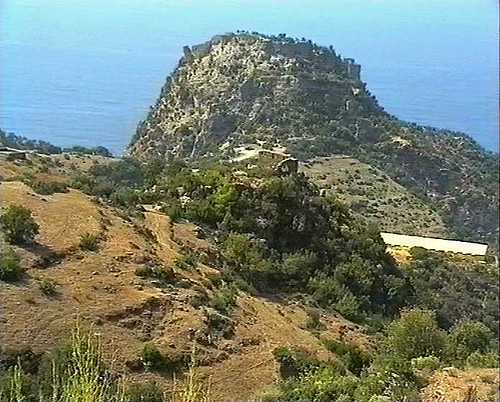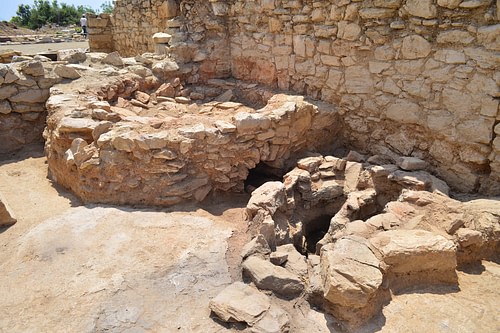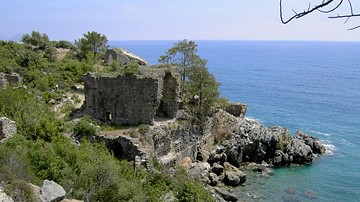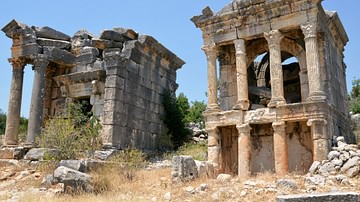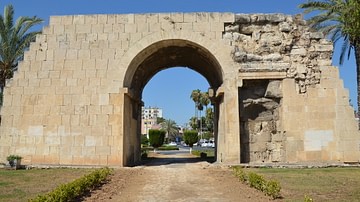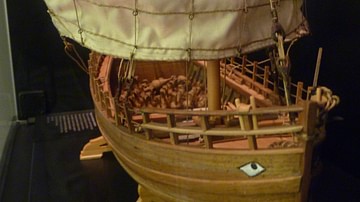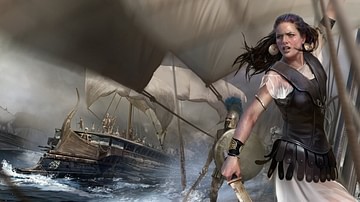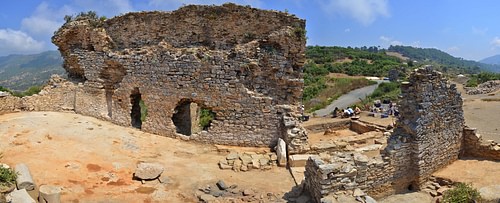
Antiochia ad Cragum (“Antioch on the Cliffs” or “Antioch at Cragus”) was a Hellenistic Roman city located in Cilicia Trachea (“Rough Cilicia”, also known as Cilicia Aspera and Cilicia Secunda) on the southern coast of modern-day Turkey (in the Gazipasa district of the Antalya province). It was founded c. 42 CE by Antiochus IV of Commagene (l. c. 17 - c. 72 CE; r. 38-72 CE), not by Antiochus IV Epiphanes of the Seleucid Empire (r. 175-165 BCE) as claimed by numerous online sites. Antiochus IV of Commagene was the last ruler of the Kingdom of Commagene before it was added to the Roman Empire as a province and was a friend to Rome who was rewarded with coastal land overlooking the Mediterranean Sea.
The city was located in an area previously associated with the Cilician pirates who favored the rocky coastline and numerous concealed harbors of Cilicia Trachea. The harbor of Antiochia ad Cragum, in fact, was probably one such harbor. The present site of the ruins of the city features a number of structures including the Northeast Temple, temple tombs, domestic housing, a basilica, a monumental gate, a colonnaded street and agora (market), a huge bathing complex, latrines, and two churches. The site has been under excavation by ACARP (Antiochia ad Cragum Archaeological Research Project) since 2005 CE and, in 2012 CE, director Michael Hoff discovered there the largest mosaic ever uncovered in Turkey. In 2018 CE, the latrines were fully excavated, revealing ancient off-color jokes depicted on the walls.
It probably took 30 years to complete the city (based on knowledge of how long it took to complete a project like the monumental bathing complex there) and may not even have been finished when Antiochus IV was deposed by Rome and forced to leave in 72 CE. The city was administered by Rome afterwards and eventually passed to the Armenian Kingdom of Cilicia (1080-1375 CE). The Knights Hospitaller used the city in the 14th century CE after which it seems to have been abandoned.
The Region
Cilicia was first inhabited c. 2500 BCE by the Luwians and Hatti before it was conquered by the Akkadian Empire (between 2334-2083 BCE), the Hittite Empire (c. 1700-1200 BCE), the Assyrian Empire (c. 700-612 BCE), Persian Empire (547-333 BCE), Alexander the Great (333-323 BCE) and the Seleucid and Ptolemaic empires between c. 323-103 BCE. From the earliest records on down, Cilicia was always referred to as a region of two distinct areas which were known to the Romans as Cilicia Pedias (“flat” or “smooth” Cilicia of the low plains) and Cilicia Trachea, the mountainous territory. In 103 BCE, Rome first became officially involved in the region when they invaded in an attempt to control the problem of piracy.
The Cilician coast was a haven for pirates of all nationalities who plundered ships and ports throughout the Mediterranean. Rome tried again to curtail the Cilician pirates 78-74 BCE and, even though the results were a little more promising, this was another land campaign which did little to address the actual problem. In 67 BCE, Pompey the Great (l. c. 106-48 BCE) took on the pirates as part of his initiative against Mithridates VI (r. 120-63 BCE) and fought them at sea, defeating them in 89 days by 66 BCE. He then redistricted Cilicia (naming the “smooth” area Cilicia Campestris and the “rough” Cilicia Aspera). He then relocated the captured pirates to the lowlands and Rough Cilicia was left more or less alone until the period of the Roman Empire when Augustus joined the two districts with Syria in 27 BCE and ordered roads built which connected the new province of Syria-Cilicia Phoenice with the rest of the world.
Kingdom of Commagene & Rome
A small kingdom bordering this province was the Kingdom of Commagene (163 BCE - 72 CE). It was part of the Seleucid Empire until the death of Antiochus IV Epiphanes in 165 BCE, after which it broke away and formed itself as an independent kingdom with its capital at Samosata (modern-day Adiyaman province, Turkey). The kings claimed descent from Persian, Armenian, Macedonian, and Seleucid-Greek royalty and incorporated all of these cultures in their religious beliefs and architectural designs. Images of Persian deities sat alongside Greek, and the names of both were often combined in the worship of a single god or goddess.
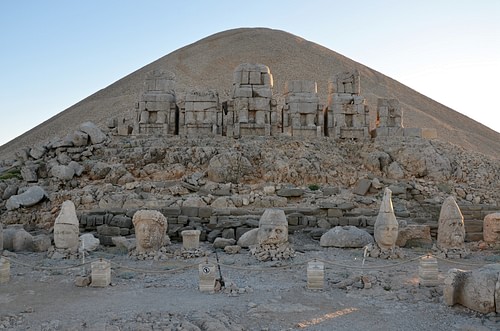
One of the greatest of these kings was Antiochus I Theos of Commagene (r. 70-38 BCE), best known in the modern day for the monumental site of Nemrut Dag he had constructed in 62 BCE on Mount Nemrut. Antiochus I, among his other accomplishments, had supported Pompey's initiative against the Cilician pirates but was a skillful enough diplomat to keep Commagene from Rome while still maintaining a cordial and mutually beneficial relationship. This bond was maintained by Antiochus I's successors, all of his dynasty, down to his great-great-grandson Antiochus IV of Commagene.
Antiochus IV of Commagene
Antiochus IV was the son of Antiochus III Epiphanes (r. 12 BCE - 17 CE) who died shortly after the boy was born. The Roman emperor Tiberius (r. 14-37 CE) annexed Commagene into the Roman province of Syria-Cilicia after Antiochus III's death since his son was too young to rule and the court at Commagene, apparently, was not interested in appointing a regent and appealed to Rome for intervention. Antiochus IV and his sister, Iotapa (r. 38-52 CE), were raised in Rome and formed important networks with some of the most influential nobility while also being granted Roman citizenship. They would eventually marry, even though they were full brother and sister, prior to Antiochus IV becoming king at Antiochia ad Cragum and go on to have three children.
Among the most important friendships he forged was the one with Caligula, the adoptive grandson of Tiberius, member of the royal Julio-Claudian dynasty, and future infamous emperor (r. 37-41 CE). Shortly after Tiberius' death, once Caligula had secured the throne, he returned Commagene to Antiochus IV in 38 CE along with all the revenue it had earned as a Roman province since its annexation in 17 CE, no doubt a substantial sum (given by some historians as upwards of one million gold pieces). He also added a large part of Cilicia Aspera to his friend's kingdom, the part along the coast of the Mediterranean which had formerly been part of the kingdom of Archelaus of Cilicia (l. c. 8-38 CE), a distant relative of Antiochus IV.
Later that same year (or possibly the next), Caligula and Antiochus IV had some falling out and the emperor took his gift back (at least the kingdom, not the money). What Antiochus IV did at this time is unknown, but he reappears in the historical record in 41 CE after Caligula is assassinated and his successor Claudius (r. 41-54 CE) returned Commagene along with the Cilician lands to Antiochus IV.
Antiochia ad Cragum
Antiochus IV presumably used the money given to him by Caligula to build his city of Antiochia ad Cragum at the base of Mount Cragus overlooking the Mediterranean Sea. Almost all of the structures (except the later churches and the gate) are now collapsed, but there would have been a palace/administrative building in addition to the domestic housing identified and the other structures mentioned above.
The temple (currently referred to as the Northeast Temple) may have been dedicated to Zeus as his figure and image appears among the ornamentation, but Apollo is even more prominently suggested, and there are many other images as well. It would seem Antiochus IV was following in his family's and culture's tradition of syncretism by combining the images of different cultures and belief systems, just as Antiochus I had done at Mount Nemrut centuries before. Luwian and Hittite imagery is combined with Greek architecture and Persian and Armenian influences for what must have been an impressive structure.
The Temple measured 54 feet long by 33.8 feet wide (16.465 x 10.32 meters) and was constructed on a raised plateau so it would have been the tallest building in the city (in keeping with traditional construction of the time, and earlier, which elevated its temples). The pillars were topped by Corinthian capitals decorated with various mythological motifs and its geisa (cornices) followed suit, emphasizing flowers and images such as the double axe, the crab, turtle, and leopard. Of special interest is the flower motif which echoes the culture of the ancient Luwian people of the area as well as the Hittites. According to scholar Geraldine S. Dobos, Luwians and Hittites used flowers to indicate specialness (105). Dobos goes on to note:
The six-petal flower [which appears in many different places on the temple ruins] is a Hittite hieroglyph used as a symbol in the picture field or on the circumference of seals, alone or accompanied by the symbols for Life and Health and it may characterize the Sun god or appear as a winged disc above him. The name of the Festival of the Crocus, which is held in the spring, and the six-petal crocus pertain to a variety of one of Turkey's native flowers which may have rounded or elongated and pointed petals. (109)
The flowers, as well as other imagery at the site, are solid evidence of Antiochus IV's use of indigenous imagery in ornamenting his city. The same paradigm appears in the grand mosaic of the bath complex which employs variations on the same sort of imagery. The Great Bath, which seems to have been the center of the city, measured 114 feet long by 65 feet wide (35 x 20 meters) and encompassed an area of 5,249 sq. feet (1,600 sq. meters). The colonnaded street led from the monumental gate directly to a covered portico, with mosaic floor, beside the pool. This portico, or perhaps a structure on the other side, may have been the apodyterium (basically, bathhouse, where one placed one's street clothes before entering the bath). The structure of most Roman baths is that one then entered the hottest water (caldarium) which opened up the pores before moving to the warm water of the tepidarium and finishing one's bath in the frigidarium (cold water) which closed the pores. Scholar Holly J. Staggs suggests that the northernmost chamber of the complex at Antiochia ad Cragum is the frigidarium. Staggs also comments on the significance of the complex for the people:
Bath architecture…was a significant cultural phenomenon in the ancient world and the ritual of bathing itself became immensely popular during this time…this costly type of architecture would have been a tool used by the inhabitants of these cities to draw populations into the region. It also would have been used to signal to Rome its allegiance and acceptance into the empire. (1)
The discovery of the largest mosaic yet found in Turkey at the bathing complex supports Staggs' contention, as it would have added considerably to the grandeur of the complex. The pool itself is an engineering marvel in keeping with Roman technology evident elsewhere. Lead pipes (evident at the site) would have drawn fresh water in, and drains would have let old water out; though precisely which pipes at the site did which is unclear (according to Steadman & McMahon, p. 214).
Citizens of Antiochia ad Cragum or visitors to the city would have enjoyed the immense bath, with a bench built into it ringing the sides, and the view of the landscape descending to the sea below. Depending on how one calculates the ratio of the Roman monetary unit sesterces to dollars, the bath complex would have cost at least $200,000.00 and possibly as much as $1,300,000.00, but Antiochus IV must have considered it worth it and it probably was.
Problems with Rome
It is unknown exactly when Antiochus IV began building the city, but it is known he founded the coastal city of Iotapa (modern-day Aytap) in 52 CE after the death of his sister-wife, and Antiochia ad Cragum must have been well underway by then. He must have had significant resources as he is said to have founded other cities as well during or after the construction of Antiochia ad Cragum. It should be remembered, however, that he was king of Commagene and received revenue from the kingdom in addition to whatever he had been given by Caligula and other gifts he may have received from others which are unknown. His wealth was recorded, however, and he was recognized as among the richest tributary rulers.
He continued his good relationship with Rome, providing armies when asked. Vespasian (r. 69-79 CE) was proclaimed emperor by the Roman Senate when he was still on campaign in Egypt in June 70 CE and Antiochus IV supported him over other contenders in Rome. Antiochus IV also sent troops to swell the ranks of Vespasian's son Titus (the future emperor, r. 79-81 CE) in his campaigns in Judea in 70 CE and remained in every way a model tributary king.
Even so, Vespasian was extremely paranoid and uneasy when he came to power and was prone to believe the truth of any plot, real or imagined. To be fair, he had good reason to do so, and his anxiety was hardly lessened by a number of provable conspiracies launched against him. In 72 CE, the senator Lucius Junius Caesennius Paetus (governor of the Syria province c. 70-72 CE), accused Antiochus IV and his sons of plotting to overthrow Vespasian and seize Rome. There is no evidence whatsoever that Antiochus IV had any designs on Vespasian's position and it is almost certain that Paetus, knowing Vespasian's paranoia and hoping to get his hands on Antiochia ad Cragus and Antiochus IV's wealth, accused him falsely.

Without any known evidence to back his claim, Paetus convinced Vespasian of the plot and was given license to march against Antiochia ad Cragum in 72 CE. The armies of both sides are known to have met on the field but what happened next is unclear. According to some reports, Antiochus IV's sons engaged with Paetus' troops, according to others, there was no battle at all. Antiochus IV himself is said to have remained aloof from the conflict although he was present when Paetus and his forces arrived.
All that is known afterwards is that Vespasian abolished the Kingdom of Commagene and deposed Antiochus IV who first went to the lowlands of Cilicia Campestris, possibly then to Greece, and finally to Rome where he was received with respect as were his sons and daughter. What happened to Paetus after the events of 72 CE is unknown as is Antiochus IV's date of death.
There is no mention of Antiochia ad Cragum after Antiochus IV leaves the city, and it is presumed to have been administered as part of the Roman province under Vespasian. It next shows up as Antiochetta under the Armenian Kingdom of Cilicia and seems to have been made use of by the Knights Hospitaller during that same time (1080-1375 CE). The Armenian Kingdom was taken by the Muslim Mamluks in 1375 CE, and the region became part of the Ottoman Empire shortly after the fall of the Byzantine Empire in 1453 CE.
Conclusion
Antiochia ad Cragum was deserted at some point and lay forgotten until the 19th century CE when it was located by the English naval officer Captain Francis Beaufort who was scouting for harbors Napoleon's fleet might use to escape and identified the city using a Byzantine travel guide (Staggs, 2; Hoff, 101). The inscriptions and images at the site were first noted and commented on by one E. L. Hicks in 1890 CE, but excavation there did not begin until the 1930s-1940s CE, with extensive archaeological work only commencing in the 1960s CE (Staggs, 2-3). Since 2005 CE, as noted above, work there has been under the supervision of Michael Hoff, Professor of History at the University of Nebraska-Lincoln, and the ACARP.
The city may have been brought down by an earthquake. In the present day, pieces of the temple not laid out, numbered, and categorized lay strewn about the site, and pillars can be found in varying distances from the temple area. A modern road runs past the remains of the city, and the ancient harbor is now a swimming hole popular among the local people who seem to enjoy it as much as the ancient people of the area must once have enjoyed the Great Bath. The people now walk down from their cars or scooters to the water as the ancients would have the colonnaded road and stray goats, perhaps the descendants of those who knew the region in ancient times, roam through the brush and scrub in the silent ruins of the once-great city of Antiochia ad Cragum.
